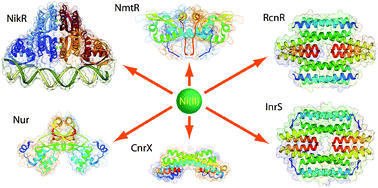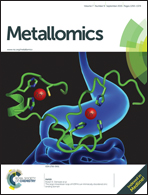Nickel-responsive transcriptional regulators†
Abstract
Nickel is an essential micronutrient for a large number of living organisms, but it is also a toxic metal ion when it accumulates beyond the sustainable level as it may result if and when its cellular trafficking is not properly governed. Therefore, the homeostasis and metabolism of nickel is tightly regulated through metal-specific protein networks that respond to the available Ni(II) concentration. These are directed by specific nickel sensors, able to couple Ni(II) binding to a change in their DNA binding affinity and/or specificity, thus translating the cellular level of Ni(II) into a modification of the expression of the proteins devoted to modulating nickel uptake, efflux and cellular utilization. This review describes the Ni(II)-dependent transcriptional regulators discovered so far, focusing on their structural features, metal coordination modes and metal binding thermodynamics. Understanding these properties is essential to comprehend how these sensors correlate nickel availability to metal coordination and functional responses. A broad and comparative study, described here, reveals some general traits that characterize the binding stoichiometry and Ni(II) affinity of these metallo-sensors.

- This article is part of the themed collection: Nickel in biology

 Please wait while we load your content...
Please wait while we load your content...